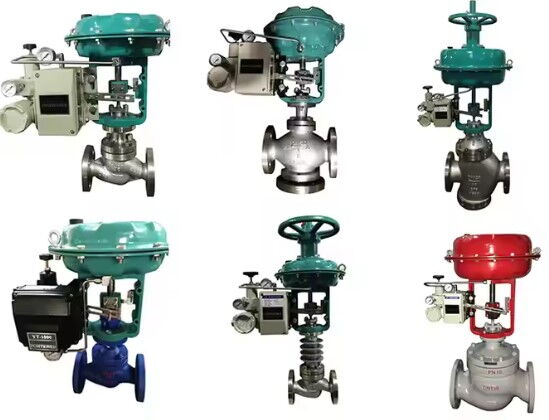Control Valve Flow Characteristic Matching and Fault Analysis
On this page
Control valves play a crucial role in automated process control systems. The way their flow characteristics match the system's requirements directly affects overall performance. When the flow characteristics don't match, it's a common cause of control system failure or reduced performance. For a system to run efficiently and stably under various conditions, the control valve's flow characteristics must align with the dynamic properties of the controlled object. In this article, we'll explore the signs, causes, solutions, and principles for choosing the right flow characteristics of control valves, helping engineers better understand and solve this issue.
Flow characteristic mismatching occurs when the control valve's flow behavior doesn't align with the characteristics of the controlled object. This can lead to poor system performance. Common symptoms include:
Sensitivity Differences at Low and High Flows: The control valve's response may be different at low and high flow rates. At low flow, the system might become overly sensitive or unstable. At high flow, it may respond too slowly or inadequately.
Saturation Nonlinearity Issues (e.g., Temperature Control Systems): If the controlled object has strong nonlinear behavior, like saturation, flow mismatching can cause high sensitivity at low flow rates and slow response at high flow rates. Alternatively, the system may overreact at low flow rates (leading to oscillations) but return to normal at high flow rates.
Linear Characteristics Issues (e.g., Flow-following Control Systems): If the controlled object has a linear response, but the valve has mismatched characteristics, it may perform well at low flow rates but show oscillations or instability at high flow rates. Conversely, at high flow rates, the system may become sluggish or unresponsive.
These mismatches can cause the system to behave inconsistently, leading to poor control, instability, or even failure in the production process.
The root cause of flow characteristic mismatching usually lies in the control valve's flow behavior not matching the controlled object's properties. Here are some common faults and how to address them.
For systems like temperature control, which have saturation nonlinearity, flow mismatching often shows as high sensitivity at low flow and slow or delayed response at high flow. This is typically due to using linear or quick-opening valves, which aren't suited for nonlinear systems.
Solution: Replace the valve with one that has equal percentage or parabolic flow characteristics. These valves handle nonlinear behavior better. Installing a valve positioner can also help improve accuracy and stability.
For systems with linear characteristics (such as flow-following control), using valves with equal percentage or parabolic flow characteristics can work fine at low flow rates but may cause instability or oscillations at high flow rates. Conversely, the system may suffer from control lag at high flow rates.
Solution: Switch to a valve with linear flow characteristics. Adjust the valve positioner to improve stability and system performance.
Choosing the wrong rated flow coefficient can cause the valve to operate outside the required flow range. This may prevent it from working efficiently within the right opening range. If the flow coefficient is too high, the valve may struggle to control flow at large openings. If it's too low, the valve may stay at a small opening for too long, reducing its effectiveness.
Solution: Recalculate the flow coefficient and select a control valve that covers the needed flow range. Factors like pipeline diameter and process requirements should be considered when choosing the right coefficient.
Choosing the right flow characteristic is key to keeping the control system stable and accurate. There are two main ways to select flow characteristics: mathematical calculations and empirical methods. While mathematical methods are more precise, they're also time-consuming, so empirical methods are more commonly used in practice. When selecting flow characteristics, consider these factors.
According to control theory, the system's open-loop gain should remain constant for good regulation quality. To achieve this, the valve's amplification factor should adjust in a way that compensates for changes in the controlled object's amplification factor. This helps keep the system stable.
The pressure drop in the pipeline system should influence the choice of valve characteristic. Different types of valves are suited for different conditions.
Linear Valve: These valves change flow significantly at small openings, which may lead to oscillations. They're best suited for systems with large pressure drops and small load changes.
Equal Percentage Valve: These valves adjust smoothly when nearly closed and are highly responsive when near full open. They work well for systems with large load variations and provide good compensation for load changes.
Quick-Opening Valve: These valves show large flow at small openings and reach maximum flow quickly. They are ideal for applications that require a fast response, like on/off control systems.
For systems with self-balancing capabilities (like constant temperature or constant flow), equal percentage valves are usually a good choice because they compensate well for load changes. For systems without self-balancing, such as flow or pressure control, linear flow valves are recommended.
Flow characteristic matching is crucial to the accuracy, stability, and responsiveness of a control system. If the control valve's flow characteristics don't match the controlled object's properties, it can lead to inconsistent system performance, reduced accuracy, or instability. By carefully selecting the right valve characteristics, recalculating the flow coefficient, and replacing the valve or adding a valve positioner where needed, you can resolve flow characteristic mismatching. In practice, it's important to consider process needs, load changes, pressure drop conditions, and the characteristics of the controlled object to achieve optimal control performance.

